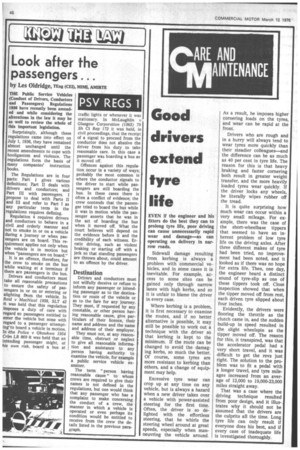Good drivers extend tyre life
Page 68

If you've noticed an error in this article please click here to report it so we can fix it.
EVEN if the engineer and his fitters do the best they can to prolong tyre life, poor driving can cause unnecessarily rapid wear and damage—as can operating on delivery in narrow roads.
Sidewall damage resulting from kerbing is always a problem with commercial vehicles, and in some cases it is inevitable. For example, access to some sites can be gained only through narrow lanes with high kerbs, and so it is unfair to blame the driver in every case.
Where kerbing is a problem, it is first necessary to examine the routes, and if no better alternative is possible, it may still be possible to work out a technique with the driver so that kerbing is kept to the minimum. If the route can be changed to avoid the damaging kerbs, so much the better. Of course, some tyres are more resistant to kerbing than others, and a change of equipment may help.
Excessive tyre wear can crop up at any time on any vehicle, but is always a hazard when a new driver takes over a vehicle with power-assisted steering for the first time. Often, the driver is so delighted with the effortless steering, that he whirls the steering wheel around at great speeds, especially when manoeuvring the vehicle around. As a result, he imposes higher cornering loads on the tyres, and wear can be rapid at the front.
Drivers who are rough and in a hurry will always tend to wear tyres more quickly than their steadier colleagues—and the difference can be as much as 40 per cent in tyre life. The reason for this is that heavy braking and faster cornering both result in greater weight transfer, and the more heavily loaded tyres wear quickly. If the driver locks any wheels, he literally wipes rubber off the tread.
It is quite surprising how much wear can occur within a very small mileage. For example, there was the case of the short-wheelbase tippers that seemed to have an inherent problem of low tyre life on the driving axles. After three different makes of tyre had been tried, no improvement had been noted, and it looked as if there was no hope for extra fife. Then, one day, the engineer heard a distinct sound of tyre-slip as one of these tippers took off. Close inspection showed that when the tipper moved off from rest, each driven tyre slipped about four inches.
Evidently, the drivers were flooring the throttle as the clutch came in, and the sudden build-up in speed resulted in the slight wheelspin as the tipper moved off. The reason for this, it transpired, was that the accelerator pedal had a very short travel, and it was difficult to get the revs just right. The solution to the problem was to fit a pedal with a longer travel, and tyre mileages increased from an average of 12,000 to 19,000-23,000 miles straight away.
That was a case where the driving technique resulted from poor design, and it illus-. trates why it should not be assumed ehat the drivers are the culprits all the time. Long tyre life can only result if everyone does his best, and if every case of inadequate life is investigated thoroughly.
















































































































